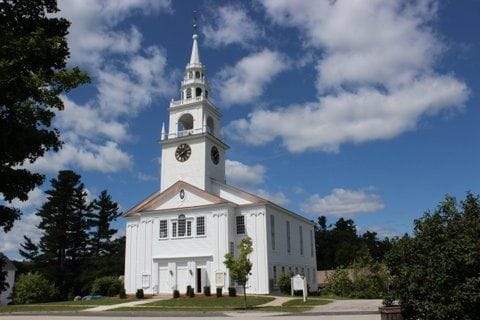The Meeting House
These places can seem less and less important as life trickles out of them while life carries on around, just fine. Until it is not, just fine.

The town helped put to rest a young man, forty-one years old, at a service this past week in the Meeting House. It was the second nearly standing-room-only service for a young, departed person in town this month. The other was a wife and stepmother of two, fifty-five, who was an active member of the Congregational Church community until the end.
A meeting house is one of New England’s most iconic symbols: plain, white, colonial structures with large windows, broad steps leading up to large, welcoming front doors, and typically, tall steeples that jut heavenward. They were erected as the first order of business in a new community, at the center of town, on the village green, where horses and wagons had room to mingle and wait while the people went inside to pray.
Space inside a meeting house is traditionally divided between the church sanctuary and the secular space for town functions. This is the case with ours. The Congregational Church occupies the main floor of the building, which is upstairs. The first floor is for general use by the town. The building belongs to neither church nor town; rather, it enjoys “common undivided interest in the whole,” which is the language that helped quiet the argument that people were being asked to pay taxes to support a church. That was back in the nineteenth century, and the courts, dealing with early tests of the Constitution, ordered the property and functions of meeting houses separated. Frugal Yankee farmers took a shortcut, built a second floor and designated it for worship.
The sanctuary of the Congregational Church in our Meeting House is beautiful, in its Puritan way, and spacious. A white-painted, conservatively ornate ceiling, white pews, wood trim, and cushioned benches; a simple bronze cross on the wall in front; organ and organ pipes, and expanses of windows on both sides, welcoming light. It is no dark place of worship. There is room for the whole town, as would have been necessary back when the whole town went to church on Sunday. Unfortunately, this place of prayer, like many around the world, has fallen on harder times because of competing distractions for people’s attention Sunday mornings and a small village population. Churches are retail businesses, after all, dependent on the same thing as a country store or inn -- volumes of shoppers, lodgers, or communicants.
And these places can seem less and less important as life trickles out of them while life carries on around, just fine. Until it is not, just fine.
Several years ago, our town had to confront the need for significant structural improvements to the Meeting House. It was pointed out that “common undivided ownership” meant a shared burden between town and church. The town rarely used the space on the first floor, run down and uncomfortable as it was. There were not enough church parishioners to foot the bill or even half of it. At the town meeting to decide the issue, there was a good deal of back and forth, and small amounts of finger-pointing about the wisdom and justice of borrowing a lot of money to improve something people weren’t using. It took an older, tenured gentleman of the community to finally stand up and explain that if you want to get married, the church will marry you. When you die, the church will bury you. It does for us. We do for it. That is how we stay together as a community.
Such commentary may have been on the mind of more than one person during the service this past week and the one a few weeks earlier. The cars were parked the length of Main Street, and in all the available spaces along the beach at the pond, in front and behind the Town Hall across the street, and at the Post Office next door. The line of people waiting to sign the book of condolences was out the door and down the steps to the sidewalk. Some dressed in jackets and ties and dresses, some in blue jeans and suspenders, some had just come from the garden, some had thought of nothing else all morning, waiting at home until it was time for the service. They filled the sanctuary early and greeted each other in whispering tones. Everyone was there you thought would be there, and plenty you did not. It was a good portion of the town, plus others from farther away, surrounding the center row of pews over which were draped purple velvet banners embroidered with the word RESERVED. They waited for that dreadful moment when the family -- mother, father, sisters, and more distant relations -- would be ushered to those reserved seats. Visibly saddened. Tired. Worn down.
You may have had the experience where you live of running into someone you know from church or school in a supermarket or a restaurant. Out of context, there can be a gap in recognition, a brief, blank look. My wife and I had that experience regularly as innkeepers, encountering people away from the inn. Not locals, but people from elsewhere around the region. We developed an easy response standing in line at the supermarket, for instance, when someone lifting groceries from their cart to the conveyer turned to see us behind them, and it was clear they were scrambling to make the connection: “Hancock Inn,” we would say. “Oh, yes, of course. How are you?” they would answer.
There was no missing context in the Meeting House at these services mourning the passing of our neighbors. Normally reliant on a small flock of Congregationalists to mow the grass, sweep the walks and keep a light on, the balance of the parish population filed in, at home, as people belonging, congregants of a church elsewhere, perhaps, but today, congregants of the town, conducting town business in the place for such business - as for 200 years - the Meeting House.
It does for us. We do for it. That is how we stay together as a community.

